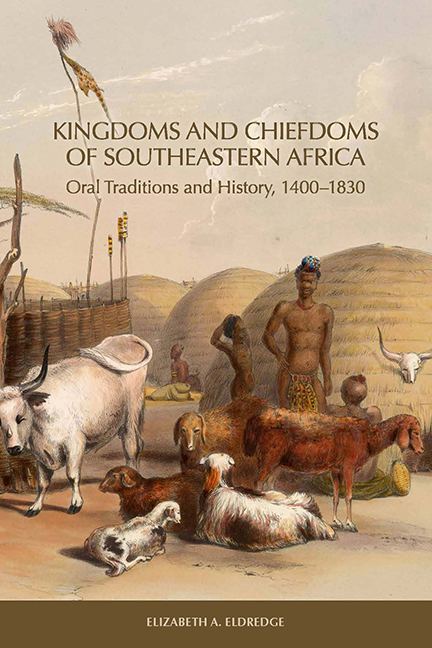Book contents
- Frontmatter
- Contents
- List of Illustrations
- Preface
- 1 History and Oral Traditions in Southeastern Africa
- 2 Oral Traditions in the Reconstruction of Southern African History
- 3 Shipwreck Survivor Accounts from the Sixteenth and Seventeenth Centuries
- 4 Founding Families and Chiefdoms East of the Drakensberg
- 5 Maputo Bay Peoples and Chiefdoms before 1740
- 6 Maputo Bay, 1740–1820
- 7 Eastern Chiefdoms of Southern Africa, 1740–1815
- 8 Zulu Conquests and the Consolidation of Power, 1815–21
- 9 Military Campaigns, Migrations, and Political Reconfiguration
- 10 Ancestors, Descent Lines, and Chiefdoms West of the Drakensberg before 1820
- 11 The Caledon River Valley and the BaSotho of Moshoeshoe, 1821–33
- 12 The Expansion of the European Presence at Maputo Bay, 1821–33
- 13 Southern African Kingdoms on the Eve of Colonization
- Appendix A Ama Swazi King Lists
- Appendix B Chronology of Conflicts, Migrations, and Political Reconfiguration East of the Drakensberg in the Era of Shaka
- Appendix C Interviewees from the James Stuart Collection of Oral Traditions
- Notes
- Bibliography
- Index
7 - Eastern Chiefdoms of Southern Africa, 1740–1815
Published online by Cambridge University Press: 14 March 2018
- Frontmatter
- Contents
- List of Illustrations
- Preface
- 1 History and Oral Traditions in Southeastern Africa
- 2 Oral Traditions in the Reconstruction of Southern African History
- 3 Shipwreck Survivor Accounts from the Sixteenth and Seventeenth Centuries
- 4 Founding Families and Chiefdoms East of the Drakensberg
- 5 Maputo Bay Peoples and Chiefdoms before 1740
- 6 Maputo Bay, 1740–1820
- 7 Eastern Chiefdoms of Southern Africa, 1740–1815
- 8 Zulu Conquests and the Consolidation of Power, 1815–21
- 9 Military Campaigns, Migrations, and Political Reconfiguration
- 10 Ancestors, Descent Lines, and Chiefdoms West of the Drakensberg before 1820
- 11 The Caledon River Valley and the BaSotho of Moshoeshoe, 1821–33
- 12 The Expansion of the European Presence at Maputo Bay, 1821–33
- 13 Southern African Kingdoms on the Eve of Colonization
- Appendix A Ama Swazi King Lists
- Appendix B Chronology of Conflicts, Migrations, and Political Reconfiguration East of the Drakensberg in the Era of Shaka
- Appendix C Interviewees from the James Stuart Collection of Oral Traditions
- Notes
- Bibliography
- Index
Summary
Oral traditions of the early peoples of KwaZulu-Natal emphasize the initiative of chiefs in subordinating neighboring chiefdoms by force and persuasion and incorporating new territory and people under their own rule. A rising incidence of hostile interaction and violence is evident for the mideighteenth century, resulting in the reconfiguration and consolidation of chiefdoms in the region. The major chiefdoms of the KwaZulu-Natal region of the early nineteenth century all trace their emerging prominence to the second half of the eighteenth century. Two major migrations affected chiefdoms both south and north of the Thukela River, from the Phongolo River in the north to the Mkomazi River in the south. The AmaThuli and AmaCele chiefdoms both migrated en masse from north of the Thukela River and reestablished themselves in positions of dominance over the existing chiefdoms south of the river. Their departure allowed for the expansion of other chiefdoms north of the river, where the Ama- Hlubi were already well-established. Nearer to the coast the AmaMthethwa, AbaQwabe, and AmaNdwandwe chiefdoms expanded into kingdoms, and the small AmaZulu chiefdom first began to expand.
Political Consolidation South of the Thukela River: The AmaThuli and AmaCele Chiefdoms
A new sociopolitical dispensation emerged south of the Thukela River before the mid-eighteenth century as the result of the migration of the AmaThuli and AmaCele chiefdoms from north of the Thukela. Both migrations involved the movement and resettlement of entire chiefdoms under the leadership of their chiefs, to south of the Thukela River, where they reestablished themselves among the peoples already there. Oral traditions identify several AmaThuli chiefs as central in the process of migration and expansion after migrating from north of the river. Before their migration two sons of the AmaThuli chief Sivuba became prominent, Dole and Tshatwa; Dole and Tshatwa's son Myebu led their AmaThuli followers south across the river. All the AmaThuli people crossed south into Natal at the same time, along with the AmaKomo and the AmaMbili peoples, because “there was a disturbance (ucuku) in Zululand,” the territory north of the Thukela River.
- Type
- Chapter
- Information
- Kingdoms and Chiefdoms of Southeastern AfricaOral Traditions and History, 1400–1830, pp. 154 - 184Publisher: Boydell & BrewerPrint publication year: 2015

